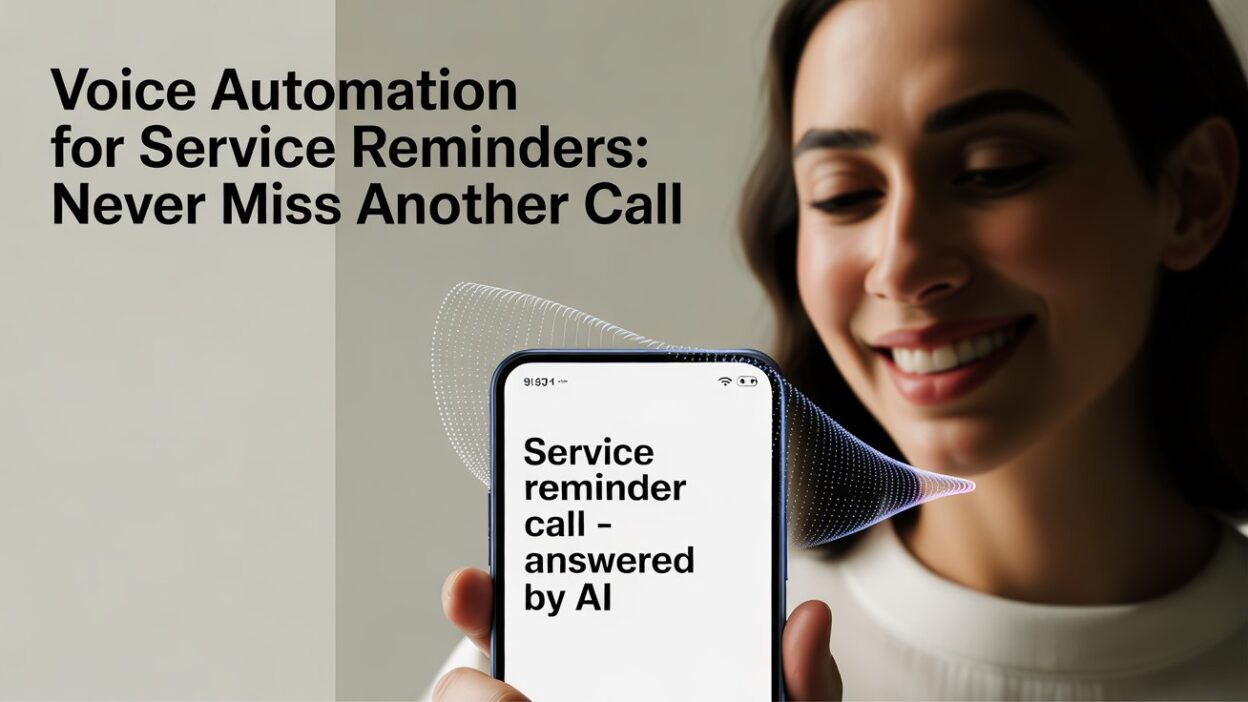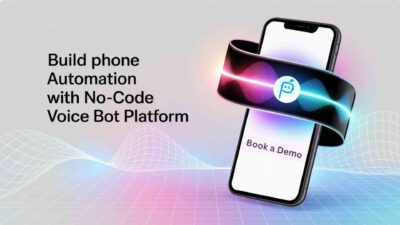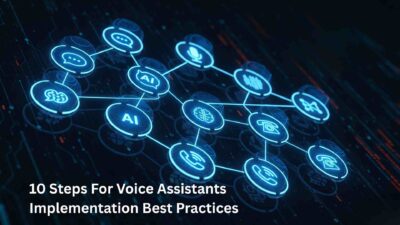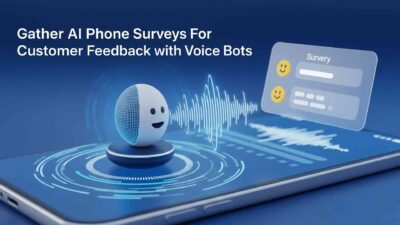An voice automation for service reminders speaks clearly about your car’s upcoming oil change. Your phone rings at 9 AM. You confirm the appointment instantly. The entire interaction takes 30 seconds.
Table of Contents
This is voice automation for service reminders in action. Smart businesses use this technology to keep customers informed. Manual reminder systems fail constantly. Voice automation solves this problem completely.
How Voice Automation for Service Reminders Works
Voice automation systems dial customer numbers automatically. The AI voice delivers personalized messages about upcoming services. Customers can respond using voice commands or keypad inputs.
The system records all responses. It updates appointment databases immediately. Failed calls get rescheduled automatically for later attempts.
Modern voice systems sound completely natural. Advanced AI technology makes conversations feel human-like. Customers often forget they’re talking to a machine.
Benefits of Voice Automation for Service Reminders
Increased Customer Retention
Timely reminders keep customers engaged with your business. Regular maintenance prevents equipment failures. Happy customers become loyal customers for life.
Studies show automated reminders increase appointment bookings by 40%. Customers appreciate proactive communication about their needs. This builds trust between businesses and clients.
Reduced No-Show Rates
Voice reminders sent 24-48 hours before appointments work best. Customers have time to reschedule if needed. Last-minute cancellations become much less common.
Dental offices report 60% fewer no-shows after implementing voice automation for service reminders. Auto repair shops see similar improvements in attendance rates.
Cost-Effective Operations
Manual calling requires dedicated staff members for hours daily. Voice automation handles hundreds of calls simultaneously. Labor costs drop significantly while efficiency increases.
One automated system replaces multiple human callers. The technology works 24/7 without breaks or holidays. Return on investment appears within the first quarter.
Industries Using Voice Automation for Service Reminders
Healthcare and Medical Practices
Doctors’ offices use voice automation to confirm upcoming appointments. Patients receive reminders about prescription refills automatically. Preventive care reminders help maintain patient health consistently.
Dental practices benefit enormously from automated reminder calls. Cleanings and checkups get confirmed days in advance. Emergency cancellations decrease by substantial margins.
Automotive Service Centers
Car dealerships send automated reminders for scheduled maintenance. Oil changes, tire rotations, and inspections get confirmed easily. Customers stay on top of vehicle care requirements.
Independent mechanics use voice systems for follow-up calls. Service completion confirmations build customer confidence. Warranty reminders protect both parties from disputes.
Home Services and Utilities
HVAC companies automate seasonal maintenance reminders automatically. Furnace inspections and air conditioning tune-ups get scheduled efficiently. Emergency breakdowns become much less frequent.
Plumbing services use voice automation for annual drain cleaning reminders. Water heater maintenance calls go out before problems develop. Preventive care saves customers money long-term.
Beauty and Wellness Services
Hair salons confirm appointments through automated voice calls. Spa treatments get verified the day before service. Client satisfaction improves through reliable communication systems.
Fitness centers send membership renewal reminders via voice automation. Personal training sessions get confirmed automatically. Class cancellations are handled smoothly through the system.
Implementation Best Practices
Timing Your Voice Automation Calls
Send initial reminders 7 days before scheduled services. Follow up with confirmation calls 24 hours in advance. Avoid calling during dinner hours or very early mornings.
Weekend calls should be limited to urgent appointments only. Business hours generate the highest response rates consistently. Test different timing strategies to find optimal results.
Crafting Effective Voice Messages
Keep messages short and clear for maximum impact. Include business name, service type, and appointment details. Provide clear options for confirming or rescheduling appointments.
Use a friendly, professional tone throughout all messages. Speak slowly enough for customers to understand completely. Include callback numbers for additional questions or concerns.
Integration with Existing Systems
Voice automation platforms should connect seamlessly with scheduling software. Customer databases need real-time synchronization for accurate information. Payment systems can be integrated for deposit collections.
CRM integration allows personalized messaging based on customer history. Service records help tailor reminders to specific needs. Advanced systems learn from customer preferences over time.
Choosing the Right Voice Automation Platform
Essential Features to Consider
Look for platforms offering natural-sounding voice technology. Multi-language support serves diverse customer bases effectively. Call scheduling flexibility accommodates different business needs.
Reporting capabilities provide insights into campaign effectiveness. Integration options should match your existing technology stack. Customer support quality determines long-term success rates.
Pricing Models and ROI Calculation
Most platforms charge per minute of call time. Volume discounts apply for businesses with high call volumes. Setup fees vary significantly between different service providers.
Calculate potential savings from reduced staff hours needed. Factor in improved customer satisfaction and retention rates. Most businesses see positive ROI within 3-6 months.
Security and Compliance Requirements
HIPAA compliance is mandatory for healthcare-related reminder calls. Payment card industry standards apply when collecting deposits. Data encryption protects sensitive customer information always.
Regular security audits ensure ongoing compliance with regulations. Customer consent mechanisms should be clearly documented. Privacy policies must explain data usage practices transparently.
Common Challenges and Solutions
Managing Customer Preferences
Some customers prefer text messages over voice calls. Others want email reminders instead of phone contact. Modern systems offer multiple communication channel options.
Preference management systems track individual customer choices automatically. Opt-out mechanisms respect customer communication boundaries completely. Regular preference updates keep systems current and accurate.
Handling Technical Issues
Voice quality problems can damage customer relationships quickly. Backup systems ensure continuity during primary system failures. Regular testing prevents issues before they affect customers.
Call completion rates should be monitored continuously for problems. Failed calls need immediate retry scheduling automatically. Technical support should be available during business hours.
Cultural and Language Considerations
Multilingual capabilities serve diverse customer populations effectively. Cultural sensitivity in messaging prevents misunderstandings completely. Local accent recognition improves customer comprehension significantly.
Holiday schedules should respect different cultural celebrations. Religious considerations may affect optimal calling times. Regional preferences influence message tone and style choices.
Future Trends in Voice Automation Technology
Artificial Intelligence Improvements
AI voices are becoming increasingly sophisticated and natural-sounding. Emotional intelligence helps systems respond appropriately to customer moods. Machine learning improves conversation quality over time automatically.
Predictive analytics identify optimal calling times for individual customers. Personalization engines create unique messages for different customer segments. Voice recognition accuracy continues improving with technological advances.
Integration with Smart Home Devices
Voice assistants can deliver service reminders through home speakers. Smart calendars automatically sync with business scheduling systems. IoT devices trigger maintenance reminders based on actual usage.
Home automation systems coordinate service appointments with family schedules. Vehicle integration provides maintenance alerts based on mileage data. Wearable devices can remind users about health-related appointments.
Advanced Analytics and Insights
Detailed reporting shows which reminder strategies work best. Customer sentiment analysis reveals satisfaction levels with automated calls. A/B testing optimizes message content for maximum effectiveness.
Predictive models identify customers likely to miss appointments. Behavioral analytics improve timing and frequency of reminders. ROI tracking demonstrates the financial impact of voice automation investments.
Getting Started with Voice Automation Implementation
Planning Your Voice Automation Strategy
Define clear objectives for your reminder system implementation. Identify which services need automated reminders most urgently. Set measurable goals for appointment confirmation rates and customer satisfaction.
Create a timeline for gradual system rollout across departments. Train staff members on new processes and procedures. Establish backup plans for handling system failures gracefully.
Testing and Optimization
Start with a small customer segment for initial testing. Monitor call completion rates and customer feedback carefully. Adjust message content and timing based on early results.
Expand gradually to larger customer groups after successful pilots. Continuously optimize based on performance data and feedback. Regular reviews ensure the system meets evolving business needs.
Measuring Success and ROI
Track key metrics, including appointment confirmation rates, consistently. Monitor customer satisfaction scores before and after implementation. Calculate time savings from reduced manual calling efforts.
Measure revenue impact from improved appointment attendance rates. Document cost savings from reduced administrative overhead expenses. Regular reports demonstrate ongoing value to business stakeholders.
Read More: Conversational AI Outbound Calls: Best Practices & Results
Conclusion
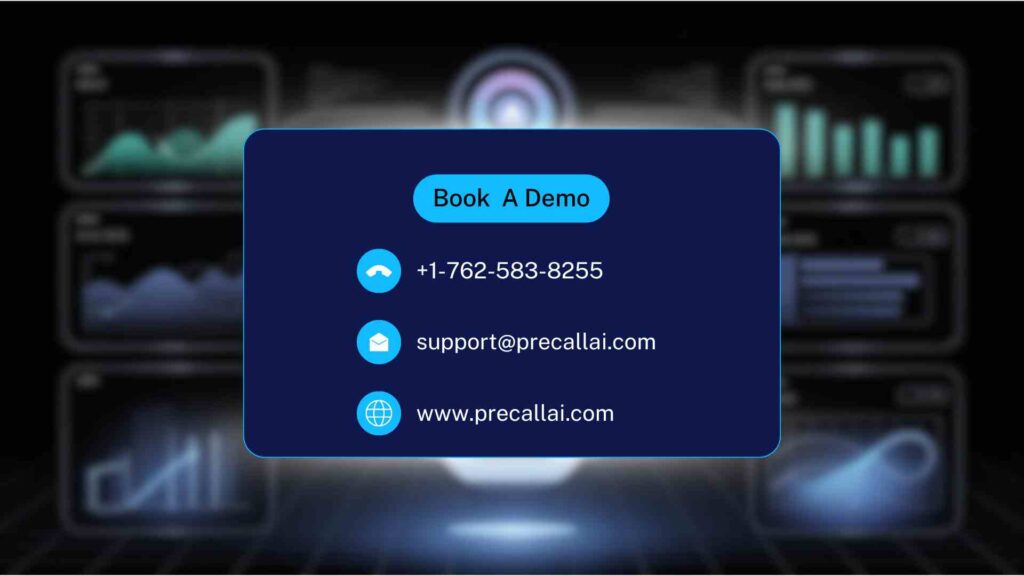
Voice automation for service reminders transforms how businesses communicate with customers. Manual reminder systems waste time and miss opportunities constantly. Automated voice technology solves these problems while improving customer satisfaction.
Smart businesses are already implementing these systems successfully. Customer retention improves when people receive timely service reminders. No-show rates plummet with consistent automated communication strategies.
The technology continues to advance rapidly with new features being added regularly. Early adopters gain competitive advantages over slower-moving competitors. Voice automation for service reminders represents the future of customer communication.
Your business can start benefiting from this technology immediately. Choose a platform that meets your specific industry requirements. Success comes from consistent implementation and continuous optimization efforts.
The question isn’t whether to implement voice automation. The question is how quickly you can start improving customer relationships through better communication. Your competitors are probably already planning their implementations.


